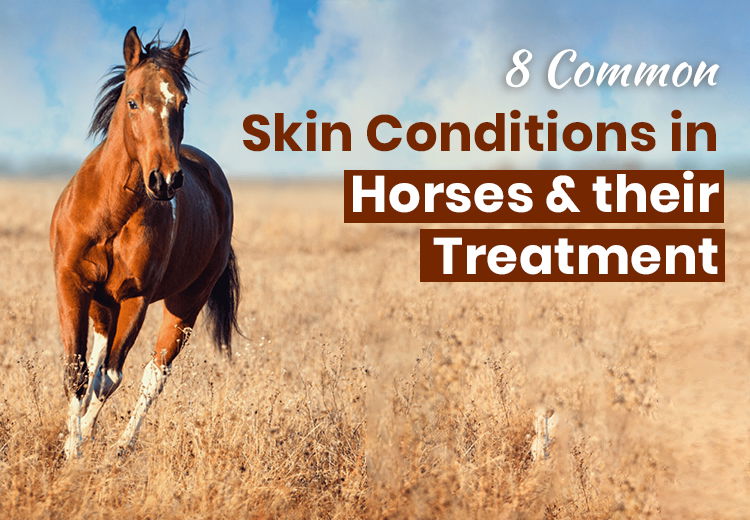May 12, 2025

Horses are prone to various skin conditions. From mere skin irritation to severe health consequences, skin problems can cause great discomfort to these majestic creatures. So, how to spare your equine friend from various skin infections? The answer is simple, i.e., by identifying the skin condition and providing them with the required treatment on time. And how do you do that? Well, we will help you.
Read on to learn about different types of skin conditions in horses, including the most common ones and ways to treat them.
Horses are susceptible to numerous skin conditions classified into the following categories:
Here is a list of 8 skin problems most commonly found in horses and simple tips to treat them:
Rain rot or rain scald is caused when bacteria and fungus develop and multiply on the horse's damp/muddy coat. Equine body areas like shoulders, hindquarters, or lower legs that are persistently exposed to damp environments develop raised bumps, upright tufts or matted hair, crusty areas, and bare spots with pus.
Treatment: Remove the infected horse from wet conditions and bring them to a place where their coat can dry thoroughly. Use anti-microbial shampoos and disinfectant rinses to give a thorough bath and cleanse the skin completely.
As the name suggests, ringworms are ring-like, rounded, hairless patches found on the face, neck, shoulders, chest, or under the saddle or girth, and can spread to other parts of the body. The horse can also become itchy. This skin problem is not caused by worms, but by a fungus found in soil, and can spread through contact.
Treatment: Isolate the infected horse to restrict the spread of the infection. Clip the hair around the lesions and remove loose scabs or crusts. Clean the ringworm patches with antifungal antiseptic and use antifungal treatment to improve the skin condition.
In this skin condition, raised and non-painful nodules form on the normal skin in the saddle or the neck region. This can be a reaction to insect bites or environmental allergies. Though it can develop at any time of the year, it mainly develops during warm weather conditions like spring or summer.
Treatment: The most common treatment is the surgical removal of the lesions. You can also use vet-recommended oral or injectable corticosteroids and antibiotics to treat this condition.
One of the most common allergic reactions in horses, sweet itch, is caused due to insect (Culicoides) bites, midge or mosquito bites. It is also known as summer dermatitis or summer eczema. It leads to incessant itching/scratching in horses, resulting in hair loss, crusty or broken skin, and bald spots around their neck, back, and dock areas.
Treatment: Sweet itch is difficult to treat and thus, vets emphasize preventive measures. Use anti-itching shampoo, apply an insect repellent, and keep your horse under shelter during dawn and dusk. You can also use electric fans to deter midges from entering stables.
Warts are caused by the equine papillomavirus and are most commonly found in young horses with immature immune systems. However, adult horses are not immune to this condition. They are raised gray or pink cauliflower-like small-sized growths and can appear individually or in clusters on the muzzle or nose, around the eyes, on the ears, genitals, and lower legs.
Treatment: Warts shrink and disappear on their own over time. But surgical removal of warts is also possible if required for cosmetic reasons. As a preventive measure, you can administer health supplements to boost the immunity of your equine friend.
Mange causes round bumps, followed by large bald spots on the face, neck, mane, shoulders, groin, etc. It leads to excessive scratching, pain, and discomfort in horses. Lice (chewing lice & biting or sucking lice) are other parasites that cause hair loss from continuous rubbing in the areas like shoulder, neck, head and the base of the mane and tail.
Treatment: Disinfect and clean your horse's environment. Administer oral treatments containing ivermectin or moxidectin, as suggested by your veterinarian. You can also use permethrin sprays, wipes, shampoos, or powders to manage this skin condition.
It is a serious and potentially cancerous skin condition most often found in gray-colored horses. Melanoma appears as a black lump(s) in the areas under the horse's tail, around the anus or on the sheath of geldings. It may start as benign, but approximately 66% of melanomas eventually become malignant.
Treatment: Regular vet examinations are essential for all gray horses. Treatment for melanomas includes chemotherapy and surgery.
Also known as scratches, mud fever, or greasy heel, this skin condition is most common in draft horse breeds or other breeds with heavy feathering on the lower legs. It is the result of bacterial growth due to damp conditions that cause the formation of lesions in the pasterns and redness, flaking, and skin crusting on the lower legs.
Treatment: Clip the hair and remove the crusted skin. Clean the area with antibacterial and antifungal shampoos. You can also use topical corticosteroids as part of the treatment. Take the help of a veterinarian to get expert advice.
Horses can get infected with various skin conditions, some of which may be simple to treat and some may significantly impact their health. Be aware of the common skin conditions in horses and simple treatment options to handle them. However, it is always advisable to consult a veterinarian before starting with any treatment so that your equine companion receives the treatment that suits their condition the best and gives positive results.